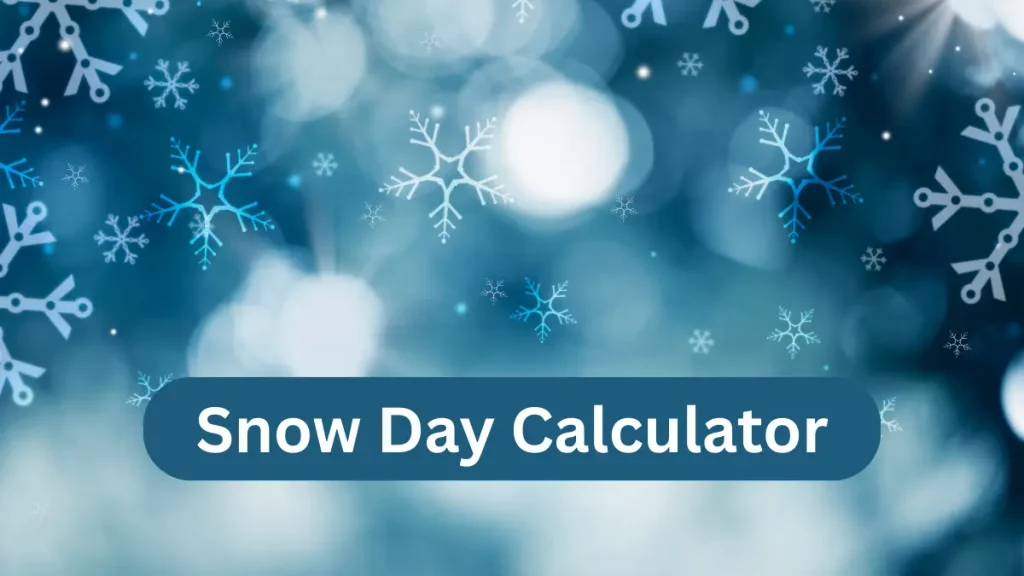Snow Day Calculator is an innovative online tool designed to predict the likelihood of a snow day based on various weather conditions and geographical data.
Snow Day Calculator
Few things spark more excitement for students and sometimes stress for parents than the possibility of a snow day. The anticipation of waking up to find school canceled due to heavy snowfall or icy conditions has become a cherished winter ritual in many parts of North America and Northern Europe. In recent years, one tool has captured widespread attention: the Snow Day Calculator 2025.
This online tool promises to predict the likelihood of a school closing based on weather forecasts, historical data, and district-specific patterns. While it’s not an official decision-making tool, it has become both a cultural phenomenon and an educational resource, blending meteorology with data science.
What is a Snow Day Calculator?
The Snow Day Calculator is a web-based algorithm that estimates the chance of school closures caused by winter weather. Originally created in 2007 by David Sukhin, then a high school student with a passion for coding and meteorology, the tool has since evolved into a popular resource for students, parents, and teachers alike.
At its core, the calculator asks users to input their zip code and school district information. It then runs that data through a predictive model that considers local weather forecasts and historical school closure trends, generating a percentage chance of a snow day.

How Does a Snow Day Calculator Work?
The algorithm is more than just a fun guessing game, it’s rooted in meteorological science and statistical modeling.
Key Factors the Calculator Uses:
- Meteorological Data
- Snowfall Amount & Rate: Heavy, fast-accumulating snow increases closure chances.
- Ice Accumulation: Freezing rain and sleet often cause more closures than light snow due to hazardous road conditions.
- Temperature & Wind Chill: Extremely low temperatures can influence closure decisions, especially when safety risks are high for children waiting at bus stops.
- Timing of the Storm: Overnight or early-morning storms are more disruptive than midday snow.
- Geographical Data
- The calculator uses the user’s zip code or district to assess storm impact in their local area.
- Topography matters: rural districts with fewer road crews may close sooner than urban areas with stronger snow removal infrastructure.
- Historical Data
- School districts have different closure thresholds. Some close at the first sign of snow, while others are far more reluctant.
- The algorithm factors in these historical tendencies to adjust predictions.
- The Algorithm
- The system combines the above factors with predictive modeling.
- While not publicly disclosed in detail, the method weighs each variable against past weather and closure records to produce a probability percentage.
This blend of forecast science and behavioral data makes the Snow Day Calculator an intriguing example of applied meteorology and statistics.
Why is the Snow Day Predictor Important? Beyond Just Prediction
Although often used for fun, the snow day predictor has broader cultural and practical significance.
- For Families:
It helps parents prepare for possible childcare needs, work schedule adjustments, or rescheduling appointments. - For Students:
The excitement of checking the calculator has become part of modern snow day culture. It builds anticipation and creates shared conversations among classmates. - Educational Value:
The tool introduces students to the role of data, probability, and meteorology in everyday life. It encourages curiosity about weather science and decision-making. - Community Connection:
The shared experience of checking predictions creates a sense of community buzz, particularly during major winter storms.
Limitations and Why It’s Not a Guarantee
Despite its appeal, the Snow Day Calculator is not an official source for school closure decisions.
- Weather Forecast Uncertainty: Predictions may shift rapidly as storms change track or intensity.
- Local Decisions: Superintendents and school boards consider additional factors the calculator cannot measure road clearing efficiency, bus safety, power outages, or even local politics.
- Geographical Coverage: While it works best in the U.S. and Canada, its accuracy may be limited in countries with different school closure practices.
Bottom line: Always rely on official announcements from your school district. The calculator is best seen as an informational and fun planning tool, not a decision-maker.
Also Check: Rice Purity Test
Frequently Asked Questions
Who created the first Snow Day Calculator?
The first version was developed in 2007 by David Sukhin, who combined his interest in coding with weather forecasting.
How accurate is the Snow Day Calculator?
Accuracy varies by region and storm conditions. It can often be surprisingly close, but it should not replace official school announcements.
What time does the Snow Day Calculator update?
The tool updates frequently as new forecast data becomes available, typically several times a day.
Does it work for all countries and school districts?
It works best in the United States and Canada, where school snow day decisions are more common. Other regions may not have enough data to provide accurate predictions.
What should I do if the calculator predicts a high chance but school isn’t cancelled?
Trust your school district’s official decision. The calculator provides probabilities, not guarantees.
Conclusion
The Snow Day Calculator represents a fascinating intersection of meteorology, statistics, and cultural tradition. By combining forecast data, historical school closures, and local geography, it offers students and parents a fun and sometimes practical way to anticipate winter disruptions.
While not perfect, its popularity highlights how technology can make science more relatable. For families, it’s a planning tool and for students, it’s a source of excitement. For educators, it’s a teaching opportunity about probability and weather science.
In the end, whether the prediction proves right or wrong, the calculator captures the joy and anticipation of a snow day, a winter ritual that continues to delight students year after year.
